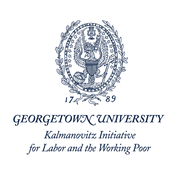I love Christmas movies because they are always about work. Want to see executive fat cats who are forced to work on Christmas Eve? Check out Scrooged, Elf, and The Family Man. Want to see elves being mistreated, overworked, and criminalized? Check out the classic stop-motion animation produced in the 1960s and 1970s by Rankin/Bass, including Rudolph, Santa Claus is Coming to Town, The Year Without a Santa Claus, and just about every other Christmas movie that has elves in it. There’s even a movie with an elf strike in it—Elf Bowling the Movie: The Great North Pole Elf Strike (2007).
Want to see Santa Claus worn out from the job? That’s the theme of all of the films in The Santa Clause trilogy that stars Tim Allen. Want to see moms losing their minds from how much work it takes to make Christmas magical? Try Bad Moms Christmas, Deck the Halls (focusing on dads, though), and Christmas with the Kranks. Want to see 19th century boot blacks, butchers, clerks, and chimney sweeps? Check out pretty much any adaptation of Dicken’s The Christmas Carol. I could go on and on, but I think you get the idea. If you like movies that are about work, and explicitly so, Christmas movies have your back.
So, imagine my delight when a new holiday series caught my eye this December: The Holiday Movies that Made Us. This series is a spin-off of The Movies that Made Us, which itself is a spin-off of The Toys that Made Us, a genius series from Netflix. It’s the perfect series for people who love Christmas movies and movies about work, because it looks at the work of making Christmas movies.
Season 1 includes a behind the scenes look at the making of Elf (2003) and The Nightmare Before Christmas (1993). What I love about this series is that it makes some of the arguments about movie making that I’ve been trying to make for years:
- Movies require a great deal of work, most of it unsung and behind the scenes, often done by people who are considered to be working class
- Movies are collective enterprises, not the singular vision of a genius auteur
- Many of the most commercially successful movies feature working-class characters and/or working-class themes
Let’s take Elf as an example. The Netflix series reveals that Elf was a surprisingly contingent movie, made by a bunch of nobodies whose only claim to fame was a weak personal link to Will Ferrell, who, at the time, was not yet a movie star. We also learn that one of the things that made Elf such a magical, modern day timeless holiday classic is that the crew built a set for the North Pole on an ice rink in Vancouver, Canada. On this set they were able to take the time—and a considerable amount of money—to explore a filming technique called forced perspective. This made Will Farrell, already a very tall 6’3”, look even more gigantic relative to the other characters.
Making Elf required more than 850 workers. This included more than 119 in the art department alone, many of them working in such non-glamourous positions as carpenter’s helper, plasterer, sign fabricator, props maker, and greensman—Hollywood lingo for the person who manages the plants and landscaping in every shot. IMDB also provides a long list of drivers, caterers, loaders, and other bottom-of-the-totem pole positions.
All of these are union jobs to boot. Hollywood is not a working-class utopia, of course. As The LA Times recently reported, entertainment unions have a whiteness problem. In addition, runaway productions—movies made outside of LA—have eroded union power. But Hollywood is still a union town, and the film unions in LA have political clout as well.
The Holiday Movies that Made Us series emphasizes the collective—rather than auteur—nature of film making. In the episode about Tim Burton’s The Nightmare Before Christmas, we learn that the story and figures were based on a few drawings Burton made while working as an animator for Disney. But Burton himself did not direct the film that eventually bore his name; indeed, his name was added as a marketing gimmick for an adult audience after the film tested poorly with children. We also learn that the Nightmare’s original screenwriter spent more time snorting coke than he did on the script, and that the Edward Scissorhands’s screenwriter, Carolyn Thompson, was brought in to save the day, in part because she was then the girlfriend of the film’s songwriter Danny Elfman. Thompson is credited with giving Sally—the girlfriend of Jack, the Pumpkin King—more depth and complexity.
The Holiday Movies that Made Us reminds us how many of these films feature working-class characters and working-class themes. Playing a human who thinks he’s an elf in Elf, Will Ferrell’s character Buddy is coded as working-class. After he leaves the North Pole, where he is humiliated for being a sub-par toy maker, Buddy works as an elf at a department store Santaland. While there, his paranoid boss is threatened by Buddy’s ability to create holiday magic, and he meets his girlfriend, Jovie, who also works as a Santaland elf. (From the series we are horrified to learn that some Hollywood suit wanted to make Jovie’s character into a prostitute.) Buddy also does a short stint in the mail room of his father’s publishing company.
Sadly, the Made Us series enriches one of the pandemic’s more despicable profiteers, Netflix Co-CEO Reed Hastings. He has a new book out, in which he brags about how often he fires employees if they are not competing at a high level, citing such company mottos as “adequate performance gets a generous severance package.” Variety called the work environment at Netflix a “culture of fear.” Now that I think about it, Hastings would make the perfect evil boss in a holiday Christmas movie!
Until that movie is made, if you’re a Christmas movie/work freak like me, enjoy The Holiday Movies that Made Us and think about the thousands of unsung underlings who work behind the scenes. And don’t forget all the other invisible workers during the Christmas season. Donate to organizations that are fighting to increase the power of working people. Remember to shop for Christmas gifts that are union made. And spread Christmas cheer by singing loudly – and safely — for all to hear!
Kathy M. Newman, Carnegie Mellon University









 So far, her record is not promising. The Alliance for Justice recently assembled a
So far, her record is not promising. The Alliance for Justice recently assembled a 
